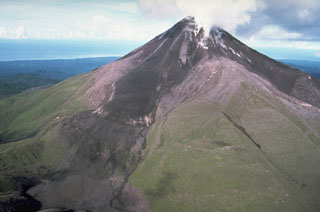Report on Bagana (Papua New Guinea) — January 1985
Scientific Event Alert Network Bulletin, vol. 10, no. 1 (January 1985)
Managing Editor: Lindsay McClelland.
Bagana (Papua New Guinea) Bulging dome; ash-laden plume; N lava flow continues
Please cite this report as:
Global Volcanism Program, 1985. Report on Bagana (Papua New Guinea) (McClelland, L., ed.). Scientific Event Alert Network Bulletin, 10:1. Smithsonian Institution. https://doi.org/10.5479/si.GVP.SEAN198501-255020
Bagana
Papua New Guinea
6.137°S, 155.196°E; summit elev. 1855 m
All times are local (unless otherwise noted)
"Bagana's summit crater dome continued growing through January, to fill 95% of the crater and bulge up to about 30 m above the crater rim. A thick, ash-laden plume was fed by numerous sources in the dome. A large solfataric area on the upper E flank of the volcano was also contributing vapours to the plume. An ash haze was observed stretching horizontally more than 100 km to the NE at about 2,000 m altitude. The steep flanks of the volcano were covered with thin ash deposits and a large number of blocks from avalanches of unstable parts of the dome.
"The long-established N lava flow was still active, and was broadening and thickening on the NW basal slopes at about 900 m altitude. Frequent avalanching was taking place from the [edges of the flow near its terminus]."
Geological Summary. Bagana volcano, in a remote portion of central Bougainville Island, is frequently active. This massive symmetrical cone was largely constructed by an accumulation of viscous andesitic lava flows. The entire edifice could have been constructed in about 300 years at its present rate of lava production. Eruptive activity is characterized by non-explosive effusion of viscous lava that maintains a small lava dome in the summit crater, although occasional explosive activity produces pyroclastic flows. Lava flows with tongue-shaped lobes up to 50 m thick and prominent levees descend the flanks on all sides.
Information Contacts: P. de Saint-Ours, RVO.

